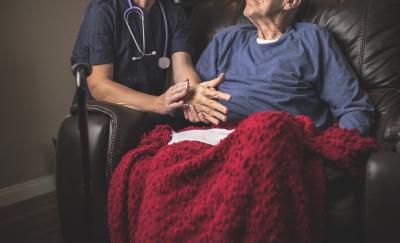Reimagining the Emergency Medical System in the Wake of COVID: A Conversation with Dr. Paul Biddinger


Demand for emergency services dropped widely during the COVID-19 pandemic but, in the Spring of 2021, is bouncing back strongly. With this comes a new set of challenges for the emergency medical system.
I sat down with Dr. Paul Biddinger, MD, FACEP, to discuss these pressing challenges, and how providers in emergency departments (EDs) and emergency medical services (EMS) can address them by leveraging lessons learned during the COVID-19 pandemic. Dr. Biddinger is the Chief Preparedness and Continuity Officer at Mass General Brigham and holds appointments at Harvard Medical School and at the Harvard School of Public Health.
“ED visits, almost everywhere in the country, went down by 40 to 60 percent in the early parts of the pandemic,” said Dr. Biddinger. ”Then, in most places, when they recovered, were still down by around 20 percent. A lot of what was happening with EDs was parallel to what was happening with EMS volume and 911 calls.”
These trends had meaningful ramifications for patients, and Dr. Biddinger cited early evidence that hospitalization rates decreased for acute conditions, and that many patients experienced delays in having cancer diagnosed and increased mortality from out-of-hospital cardiac arrest. These findings suggest that many patients with acute conditions did not receive the care they needed during the height of the COVID-19 pandemic in the U.S.
Dr. Biddinger then went on to discuss more recent trends, saying that “what’s fascinating is that, for the last 6 weeks, give or take, [demand for ED and EMS services] is setting records.” This experience has also been shared by several of his colleagues, although “these data haven’t yet shown up” in databases available to researchers or policy makers. If COVID-19 vaccination rates continue to increase and COVID-19 case rates stay low, patients who may have deferred care in the past will be increasingly comfortable seeking it now, especially for serious conditions. Dr. Biddinger reflected that this trend may lead to ED crowding and longer wait times for ambulances to arrive after calling 911 – “the exact same problems that we had pre-COVID, but worse… because of COVID testing, which is required before admission” and other safety protocols related to COVID-19, such as how patients are placed within the ED/hospital.


Still, the emergency medical system has tools to address these challenges, including many lessons learned during the COVID-19 pandemic. During our conversation, we discussed three strategies that may help mitigate these challenges to providing timely care as the COVID-19 pandemic eases:
- Use of Telehealth. Telehealth technology can be used to connect patients with a clinician during a 911 EMS encounter, allowing the remote clinician to assess the patient and determine preliminary diagnoses and treatment options. Use of telehealth by ambulance/EMS teams has been associated with improved EMS efficiency (e.g., reductions in ambulance transports to the ED, in the amount of time for ambulances to return to service) without adverse implications for patient outcomes. Through flexible approaches to reimbursements for telehealth services from CMS and other payers, “telemedicine was completely transformed during COVID-19, and nobody wants to go back to the way it was,” said Dr. Biddinger. More recently, through the Emergency Triage, Treat, and Transport (ET3) Model, CMS has begun reimbursing EMS providers who connect Medicare beneficiaries with clinicians via telehealth, offering an important option for care that was not previously available.
- Leveraging paramedics and EMTs. Models such as community paramedicine allow paramedics and EMTs to provide care to patients at their highest level of training, following carefully defined protocols to identify situations when paramedics can provide safe and appropriate care. In such models, where appropriate, paramedics who have appropriate training can staff EMS responses that do not result in transport, either through community paramedicine initiatives or through treatment in place via a model such as ET3. However, Dr. Biddinger cautioned that some areas of the country have more paramedics than others, so protocols and models relying on paramedics may not be applicable across the entire U.S. Additionally, such approaches are not without risk, and must include protocols for escalating care to hospital emergency departments or other settings staffed by physicians. While a physician consult may not always be necessary, one should always be available. For example, Dr. Biddinger explained, a swollen ankle could stem from a minor sprain but, especially in older adults, could also indicate a septic joint that requires immediate diagnosis and treatment. As he says, “You have to be careful about how an algorithm will lead you astray, because things that look benign can definitely go off the rails.”
- Connecting patients with chronic issues to appropriate community-based services. “More and more,” said Dr. Biddinger, “part of emergency care is providing a referral to the next stage of care... a lot of things are ongoing problems where a single episode of care is not sufficient.” Patients with chronic medical conditions are frequent users of EMS and hospital emergency departments. Connecting patients with appropriate community-based providers (e.g., primary care clinics) who can offer ongoing care and chronic disease management could reduce reliance on EMS and hospital emergency departments. Many patients with acute concerns fell through the cracks during the COVID-19 pandemic, and having a regular connection to care could have helped patients get the treatment they needed. Frequent users of emergency services also have disproportionately high rates of mental health diagnoses and substance use disorders, and these issues have only worsened during the COVID-19 pandemic. Connecting patients with community behavioral health services offers the potential for longer-term supportive therapy, which may help mitigate the behavioral health impacts of the combined COVID-19 and opioid epidemics. “There’s a huge opportunity to link patients with treatment services and counseling, to meet them where they are in the community and provide follow-up care.”
While demand for emergency services may continue to evolve, providers and payers can meet new challenges through innovative approaches to providing emergency care. Understanding the impacts of these approaches on health care spending and quality of care will require rigorous evaluation, incorporating both robust quantitative methods and the perspectives of patients and providers.
Read More About Our Health Policy Work

Designing a TA Program: Lessons from the Medicaid IAP
This blog provides tips for setting up a successful technical assistance program based on the evaluation of the Medicaid Innovation Accelerator Program (IAP).

Monitoring Medicare’s Home Health, Hospice, and Inpatient Rehabilitation Facility Benefits
The Centers for Medicare & Medicaid Services’ (CMS) home health, hospice, home infusion therapy, home IVIG, and IRF benefits require constant monitoring of payment policy—and revisions, as needed—to ensure they are working as intended. This enables…

Managing Opioid Use and Misuse in Older Adults
Older adults are twice as likely as the general population to have pain, and clinicians often rely on opioid treatment. As a result, opioid use, misuse, and opioid use disorder have increased among older adults, who are vulnerable to adverse reactions…

Evaluation of MCCM Suggests Promise for Medicare Beneficiaries with Terminal Illness and Cost Savings for Medicare
Typically, terminally ill Medicare beneficiaries must choose between enrolling in hospice or continuing to receive curative treatment. The Centers for Medicare & Medicaid Services’ (CMS) Medicare Care Choices Model (MCCM) gives beneficiaries the choice…
